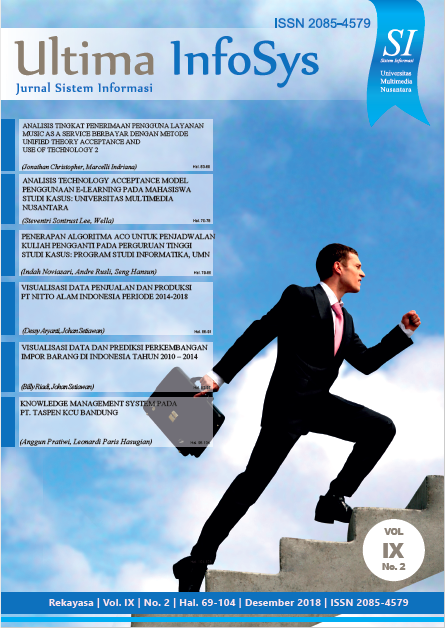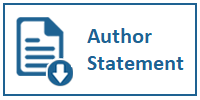Analisis Technology Acceptance Model Penggunaan E-Learning pada Mahasiswa
Universitas Multimedia Nusantara
DOI:
https://doi.org/10.31937/si.v9i2.913Abstract
Penelitian ini bertujuan untuk mengetahui faktor yang memengaruhi penggunaan elearning.umn.ac.id pada mahasiswa melalui kerangka Technology Acceptance Model (TAM). Terdapat lima konstruk asli dari TAM yang digunakan dalam penelitian ini, antara lain persepsi kegunaan (PU), persepsi kemudahan penggunaan (PEOU), sikap terhadap penggunaan (ATU), minat perilaku (BI), dan penggunaan senyatanya (AU). Terdapat pula tiga konstruk eksternal yang digunakan dalam penelitian ini, antara lain keyakinan individu (SE), aksesibilitas sistem (SA), dan kualitas sistem (SQ). Hasil yang didapatkan pada penelitian ini menemukan tingkat penerimaan dan penggunaan e-learning UMN pada mahasiswa dengan menggunakan faktor internal (perceived usefulness, perceived ease of use, attitude toward using, behavioral intention, actual use) dan faktor eksternal (self-efficacy, system accessibility, system quality) TAM sudah tinggi. Perceived ease of use tidak memiliki hubungan apapun terhadap faktor-faktor yang lain, sehingga apabila faktor perceived ease of use ditingkatkan maka tidak akan terjadi pengaruh apapun terhadap actual use, meskipun didukung dengan faktor system accessibility. Adapun pengaruh positif signifikan yang dimiliki semua pasangan variabel memiliki sifat pengurangan nilai, sehingga jika sebuah faktor independen memiliki peningkatan skor sebanyak n, maka faktor dependen yang memiliki hubungan terhadap variabel independen tersebut ikut mengalami peningkatan skor namun mengalami penurunan nilai dengan besar n sejumlah dengan nilai koefisien total pengaruh yang dimilikinya.
Downloads
Downloads
Published
How to Cite
Issue
Section
License
Authors retain copyright and grant the journal right of first publication with the work simultaneously licensed under a Creative Commons Attribution-ShareAlike International License (CC-BY-SA 4.0) that allows others to share the work with an acknowledgement of the work's authorship and initial publication in this journal.
Authors are able to enter into separate, additional contractual arrangements for the non-exclusive distribution of the journal's published version of the work (e.g., post it to an institutional repository or publish it in a book), with an acknowledgement of its initial publication in this journal.
Copyright without Restrictions
The journal allows the author(s) to hold the copyright without restrictions and will retain publishing rights without restrictions.
The submitted papers are assumed to contain no proprietary material unprotected by patent or patent application; responsibility for technical content and for protection of proprietary material rests solely with the author(s) and their organizations and is not the responsibility of the ULTIMA InfoSys or its Editorial Staff. The main (first/corresponding) author is responsible for ensuring that the article has been seen and approved by all the other authors. It is the responsibility of the author to obtain all necessary copyright release permissions for the use of any copyrighted materials in the manuscript prior to the submission.















